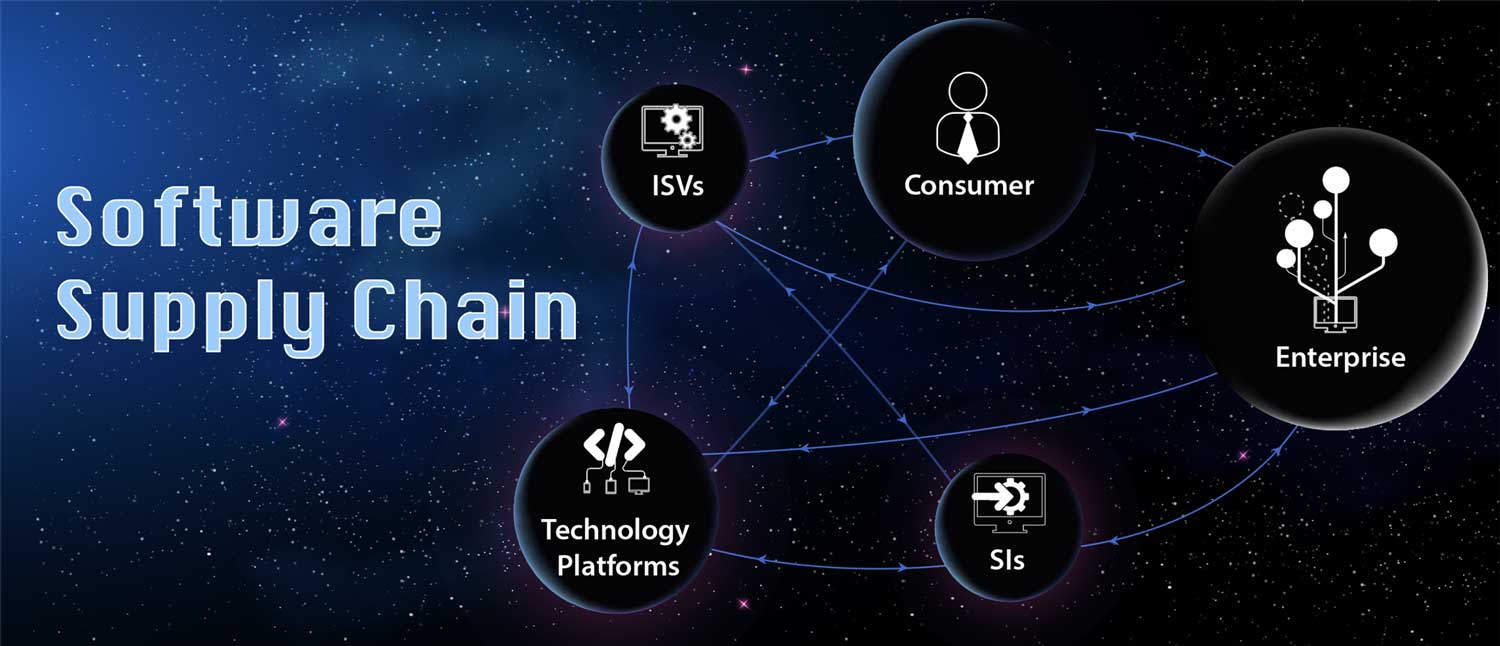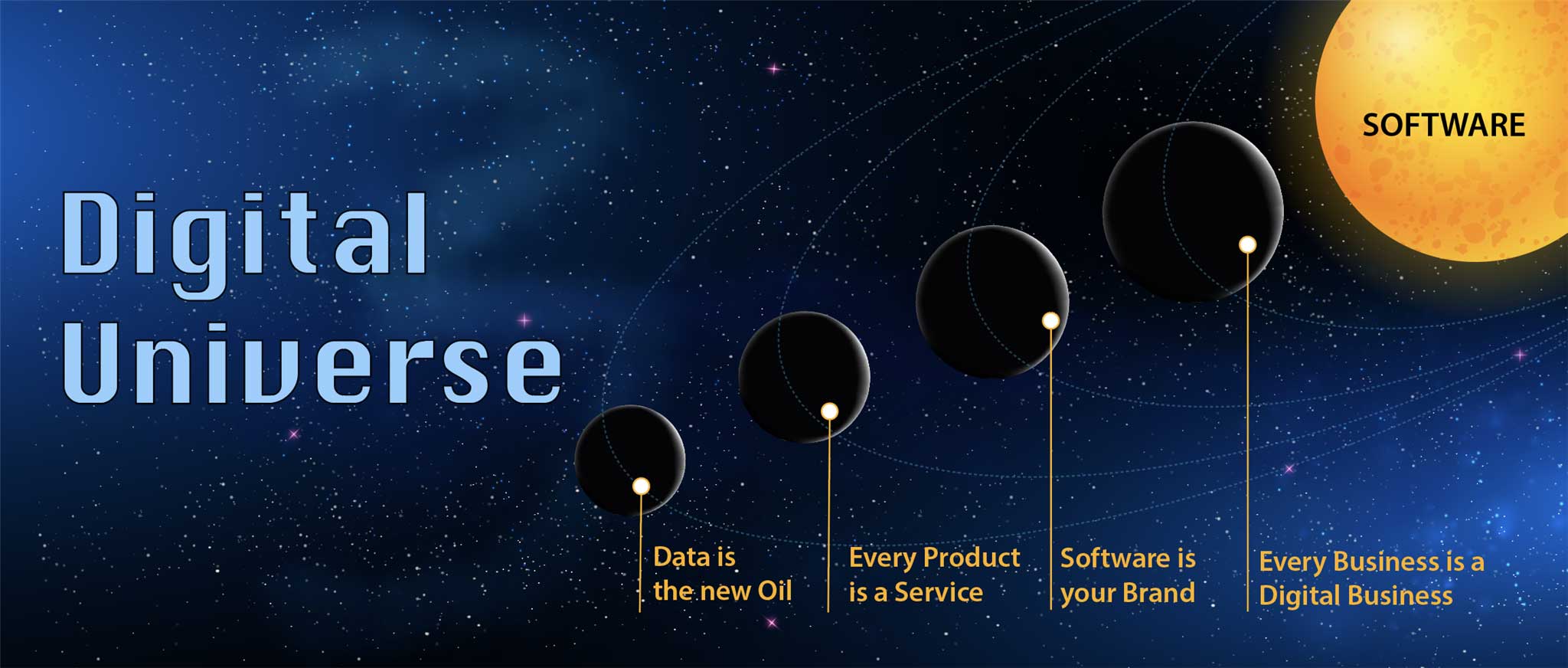Over the course of a nearly two-decade long career in the IT industry, I was a first-hand participant, player, and witness to numerous trends that have shaped the software and technology landscape. In this blog, I would like to share a rearview perspective of how the industry evolved, and my take on how dramatically the domain is being reshaped and transformed, in the most unexpected ways.
Software supply chain in the rearview mirror
When I started my career in the mid 1990s, we were bang in the midst of the PC era, and the early days of the world wide web. In hindsight, our universe appeared far less complex, with a clearly established software supply chain consisting of the following key players and participants:

- Technology Platforms consisted of industry pioneers such as Microsoft, Sun Microsystems, and IBM, who provided the basic operating system software, productivity suites, and advanced application development tools to meet consumer and enterprise business needs.
- Independent Software Vendors (ISVs) were producers of advanced packaged software, which catered to either specific domains, or supported one of the application tiers, such as the database company Oracle, and ERP vendors such as SAP, Baan etc.
- System Integrators (SIs) such as IBM, Accenture, Deloitte, KPMG, Cap Gemini and global IT service providers such as TCS, Infosys, and Cognizant, catered to specific business needs of enterprises, through consulting, implementation, and system integration solutions using a mix of packaged software, technology platforms, and custom application development.
- Enterprises were predominantly consumers of packaged software and custom applications, and used technology as an enabler for efficiency and core business automation.
- Consumer or end-users consumed software applications to support their personal computing needs and to transact with B2C enterprises for various services.
I came off age when the software supply chain looked like the picture shown above, where I dealt predominantly with CEOs, CTOs, Heads of R&D, and CIOs of software businesses and enterprises, to help them address their technology-related challenges. The nature of their challenges differed significantly, as CTOs requirement was to produce and support software IP that’s sold to other businesses, whereas CIOs gamut of responsibilities covered the management and upkeep of an enterprise’s IT infrastructure, applications, and technology assets. But, increasingly this rigid categorization is becoming irrelevant and the software supply chain that I painted above is also fast becoming anachronistic.
Digital disruption created a new, digital universe
Thanks to the unprecedented pace of technology and business model disruption, the software supply chain that I grew up in and so familiar with, is disrupted to the core, and my assumptions or beliefs are no longer relevant in the new, digital universe. The various entities that I dealt with earlier such as ISVs, SIs, enterprises, etc. are no longer central in the new universe, and their place is assumed by software. In other words, the digital universe is software-centric and software-led.
Software is everything
Perhaps the biggest revelation to me, is the evolution of software as the key success factor for even non-software businesses! Gone are the days of treating technology and software as merely enabling mechanisms to an enterprise’s core business. We now live in an age, that is defined by the breathtaking reach and possibilities enabled by digital disruption and exponential technologies. In fact, I will go one step further and argue boldly that software is not only a key differentiator, software is the new Sun powering a digital universe.

In the process of helping ISVs and enterprises deal with these tectonic shifts, I could discern a few trends that standout in this new landscape:
- Every business is a digital business: In a global economy that is increasingly digital and connected, every brick-and-mortar business is transforming into a digital business. This digital transformation has multiple facets – process, technology, and organizational. Digital processes are replacing or augmenting physical processes, adoption of emerging technologies is driving technology transformation, and organizations are becoming agile enterprises.
- Every product is a service: Due to the impact of SMAC, and the pervasive consumerization of IT, literally every product is now delivered as a service. The end user or consumer is experiencing your service and interacting with your software, (often in ways unimaginable in the past), forcing businesses to put customer experience at the heart of their service delivery.
- Software is your brand: The days of “someone else will build the software I need, and I will just use it” are in the past. The consumer is experiencing your service through your software, and it reflects your brand. And as such, you not only have the onus of safeguarding your brand, you must also own it. Which means that enterprises must develop (or acquire) sophisticated competencies to build and control their own data-enriched, software IP.
- Data is the new oil: Thanks to the impact of IoT and Big Data, zillions of terabytes data is produced, processed, and consumed every day. This humongous trove of data offers unprecedented insights on product usage, customer behavior, and emerging trends – often in real time. Just as oil was the vital and essential commodity that powered the manufacturing era, data is the indispensable fuel powering the connected, digital universe.
Why co-Creation should be at the top of your agenda?
When I shared these insights and trends with CTOs and CIOs in my customer landscape, I also realized that they are seeking help in navigating this dramatically changed digital universe. They are struggling with questions such as:
- how do I differentiate real technology trends from hype?
- which architectural patterns will make my application future-ready?
- how do I deal with emerging technologies?
Perhaps the biggest question that they would like answered, and the elephant in the room is – what’s the true north star in this new universe?
I wish I have all the answers. Based on my own experiences of the past two decades, and my sense of where we are headed, I strongly feel that at a minimum, the following drivers must be on the top of the digital agenda for any business:
- be nimble and develop the ability to dynamically respond to evolving market and business needs and faster time-to-market
- be agile in all aspects (which is as important or more than stability)
- develop capabilities to leverage emerging technologies and offer a differentiated service
“While it is important to develop critical business abilities such as agility and speed, the true north star for any business in the digital universe will be the ability to create software-IP led services and monetize data and insights generated by their own products and users”
co-Create software IP with strategic innovation partners
I also realize that this is not an easy sell to non-software, brick-and-mortar businesses. As every business seeks to transform into a digital business, they are fast encroaching onto unfamiliar and unchartered territory. I can sense that while in the past, they have focused on leveraging their core competencies, now they also face an additional challenge of transforming their accumulated domain/functional expertise and best practices into software IP.
To me, it’s clear that, even though many of these businesses are sophisticated users of software, building software IP is altogether a different and difficult challenge for most. I am a strong believer in innovation ecosystems and strengthening internal core competencies with external competencies. To any business aspiring to develop capabilities of building their own software-IP, I recommend adopting co-Creation:
“co-Creation is a powerful, new paradigm where a business seeks to complement its’ internal core competencies with an external innovation ecosystem; in this context, the technology/software capabilities of the innovation partner are leveraged to create new software IP and offer differentiated services”
In a software-centric, digital universe co-Creation not only has the potential to be a critical differentiator, but could indeed be a game changer.
Over the past decade, coMakeIT has partnered numerous innovative software businesses from across the world, to co-Create industry-leading applications in multiple domains. We will be happy to talk to you and share our insights and experiences of how co-Creation can deliver continuous business value in a disruptive landscape.




